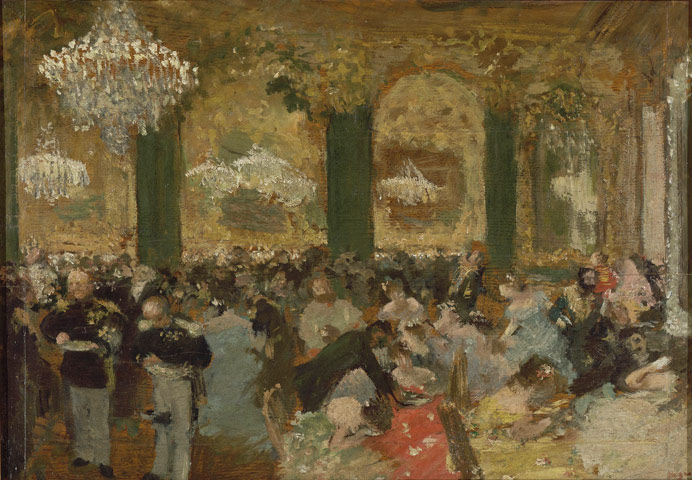Fr : version française / En: english version
mheu, Historical Museum of the Urban Environment
Dinner at the Ball
Edgar Degas

1879
oil on canvas
Musée d'Orsay, Paris
© RMN (Musée d'Orsay) / Hervé Lewandowski
View this work in the exhibition Fire
The work
Here Edgar Degas copied a painting by the great artist Adolph Menzel, "Dinner at the Ball." Menzel's painting was finished in 1878 and exhibited in Paris the following year with other works by the German artist. It is easy to imagine what a pleasure it was for Degas to copy this work, both because of its theme and its dazzling depiction of light. In 1880 La Gazette des Beaux-Arts underscored Menzel's virtuosity in the rendering of light: "His passion for light at times spurs him to overcome great difficulties; he tracks light's undulations and vibrations from every angle, the way they tail off subtly, their sharpness, the way they glint off jutting objects, their artful creation of transparency in shadows and how they transform tone by adding the clean coloration they bring with them from their sources."
The artist
Born in Paris in 1834, Edgar Degas (real name de Gas) belonged to a rich bourgeois family of Neapolitan origin. He did not begin his study of painting until 1855, after receiving a classical education. However, attracted by the Renaissance painters, he left for Italy, where he traveled from 1856 to 1860. He went first to Naples, staying with relatives, then on to Rome and Florence, where he met Gustave Moreau. The paintings of his youth, mostly portraits of his family members, are neoclassical in style. Yet Degas's interest in intimist and risqué subjects (cabarets, theaters and bordellos), his compositions inspired by photographic framing (high-angle and low-angle shots) and his long conversations with his friend Manet gradually put him off that style. As of 1874, he began frequenting impressionist painters, though he did not subscribe to their theory about light (he preferred artificial light) or enjoy working on subjects (he painted solely from memory). Degas, then, is an unclassifiable artist, who stopped painting in the early 1890s—he was very nearly blind by then—but who continued to sculpt until his death in 1917.